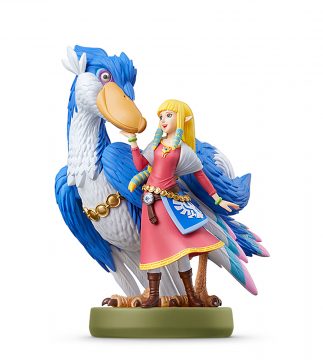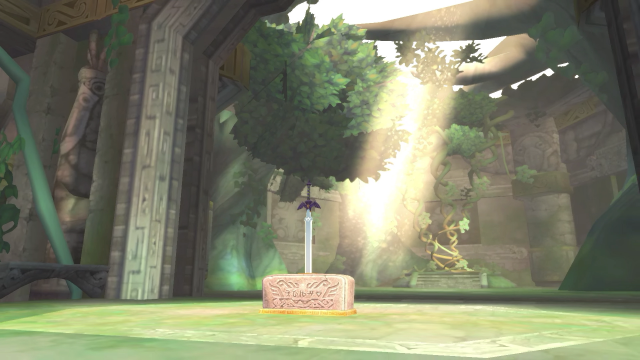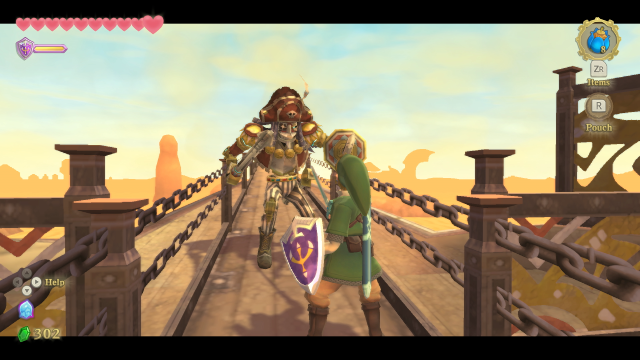Motion controls are better than ever and the superior way to play; traditional controls are implemented well and work fine; incredible score; great story that fills in the origins of Hyrule and the Triforce; smart dungeon design
Truncated overworld is still a bit of a letdown; a little slow to start, but Fi is far less intrusive, which helps
Note: This review will avoid major spoilers for those who have not played the original Skyward Sword on Wii.
The Legend of Zelda: Skyward Sword HD has reminded me why I loved the game so much when it first launched on Wii ten years ago. My original save file for the game totaled over 150 hours. Yet, despite such a huge investment of time into Link’s pursuit of the Triforce, after almost a decade I couldn’t clearly recall why Skyward Sword was so endearing to me. During a 7 Minutes podcast I had actually debated whether or not Skyward Sword was my least favorite Zelda game. After returning to Skyloft in The Legend of Zelda: Skyward Sword HD, the cobwebs have been cleared. What’s more, this version of the game has proven itself to be the superior in many ways. I can’t believe I actually debated if this was one of the worst Zelda games. Skyward Sword HD is easily one of the best.
Skyward Sword HD is set at the beginning of the Zelda timelines. It’s the nexus from which all of the other games spring. Link and Zelda are residents of a place called Skyloft, a town positioned atop an enormous chunk of rock suspended in the sky over a heavy outcropping of clouds. The Triforce is unknown to its residents and the world beneath the clouds is considered to be a wasteland lost long ago to hordes of monsters. Eventually, calamity strikes and both Zelda and Link find themselves forced below the clouds to explore the surface and fulfill their destinies. If this is your first time playing Skyward Sword, I’d like to direct you to our original review from 2010. For this analysis, I’ll be focusing more on the changes and additions in the Switch version.
The most significant change in Skyward Sword HD comes in the form of its optional traditional control scheme. Skyward Sword HD can be played entirely without motion controls, which were the centerpiece of the Wii version of the game. I was amazed that the Australian studio Tantalus (developers of Twilight Princess HD) was able to so successfully take all of the different Wii Remote commands and extrapolate them onto button and control stick inputs. Everything from Link’s sword swings to guiding the Beetle device through corridors has been reworked, and it all feels shockingly natural. At the same time, however, there are some areas where the control scheme is slightly lacking. Utilizing L3 and R3 functionality is clunky for things like shield bashing and sword jabbing. The camera can now be manipulated 360 degrees via the right analogue stick, but only while pressing the L button—because the right analogue stick is otherwise how the player swings Link’s sword around. There are other examples, none of which are game-breaking, but they are noticeable.
I’m trying to avoid nitpicking the control scheme too much because it definitely works well. I think the issue is that Wii’s Skyward Sword control setup was the absolute heart of that game. The Wii Remote was utilized in so many clever ways, fostering visceral gameplay that plopped players right into the boots of Link like never before. Reducing such wildly experimental and engaging controls into what is ostensibly an antithetical form diminishes the impact somewhat. Thankfully, for those who want to experience Skyward Sword HD the way it was meant to be played, the motion controls are still there, accessible by playing with detached Joy-Con. Played this way, players will find that the controls provide greater precision than on Wii, with the benefit of more buttons and the right analogue stick to take advantage of the free moving camera (without having to hold L). What this means is that Skyward Sword HD can be played two different ways and both work great—but the motion controls are king. I strongly recommend trying to play this way.
I’m going to differ from our Wii reviewer’s opinion in that I really enjoyed Skyward Sword HD’s narrative. Link and Zelda’s relationship is truly sweet, and because they have a genuine connection to one another the stakes feel higher. Of course, it’s a Zelda game, so don’t expect Shakespeare here, but as an origin for the entire series’ lore, Skyward Sword is fascinating. I refuse to stump for Groose, but there’s no denying his arc is satisfying (if predictable). I do agree with our reviewer, however, that the opening hours of the game drag a wee bit. There are multiple tutorials to get through, exposition setting up the cast, and so on. That said, Skyward Sword HD mitigates much of Link’s partner Fi’s extraneous hand-holding. In the original Skyward Sword, Fi was relentless in pointing out every little thing that Link needed to do. Here, her commentary is restricted to all but the most necessary prompts. It’s a major upgrade over the Wii version of Skyward Sword.
Speaking of upgrades, Skyward Sword HD boasts 1080p resolution and 60fps gameplay. The latter is imminently apparent from the outset; all of the animations and gameplay are silky smooth, lending the proceedings mesmerizing fluidity. However, as crisp and beautiful as the graphics look thanks to the resolution and processing bump, some of the watercolor-like quality of the visuals are lost. On Wii, the max screen resolution is 480p (using component cables), which is roughly the quality of a DVD. The designers at the time used this lack of crispness to insert textures that depended on being washed out or even slightly blurry to achieve an effect not unlike a watercolor painting. In Skyward Sword HD, some of these textures don’t look quite right with the better fidelity. Regardless, Skyward Sword HD’s production values are top notch a decade later. The creativity of the bosses, the characters, even the world design is the stuff that most studios would kill to achieve on their best day. A personal favorite remains floating across the Lanayru Desert with the landscape in a constant transition between sand and ocean. Of equal quality is the music. Skyward Sword’s score is one of the best in the series, hands down.
If there’s a remaining, glaring problem with Skyward Sword HD, it’s the relative linearity compared to other Zelda games. This is owed in part to the world structure of this iteration of Hyrule. Skyloft rests amidst a sea of clouds pocked with small rock “islands.” Unlike the actual islands peppered across the surface of the Great Sea in The Wind Waker, the floating rocks dotting the cloudscape surrounding Skyloft are barren. Few have anyone to interact with, and their secrets aren’t even attainable until they’ve been “unlocked” down on the surface. It makes roaming the sky rather pointless other then to get from portal to portal to explore down on the ground. This in turn means that the focus is more on completing primary story objectives versus idly wandering around.
Hyrule, meanwhile, is only accessible in chunks, with the heavy clouds overhead used as the excuse for this segmentation. There are three main areas to traverse—Faron Woods, Eldin Volcano, and Lanayru Desert. While each region is fairly large, and there are certainly secrets to discover, the truncated map diminishes any sense of a true overworld. It’s the polar opposite of Breath of the Wild, certainly, but even the Hyrule of Ocarina of Time has a better sense of vastness. Compounding things is the incessant backtracking. Players will return to each area three times apiece. The objectives change, of course, and in some instances the regions are wildly different owing to some calamity or other, but in general the retreads feel manufactured. Granted, Nintendo’s designers could only create so large of a game world due to Wii’s technological limitations, but I feel like Retro Studios tackled Metroid Prime 3’s exploration in a similar way but with better results. Today, Skyward Sword HD’s piecemeal landscape is beautiful to look at, but fails to live up to the spirit of other Zelda worlds.
One other gameplay quirk that I’d like to touch on is the repeated boss battle with The Imprisoned. Link and the enormous beast face off multiple times in fights that are mostly the same. I want to stress the “mostly” in that sentence, because I feel that there’s enough variance between each bout to keep the engagements fresh and interesting. There’s also plentiful time between these battles, such that I honestly have never understood the grousing about fighting The Imprisoned. I’d also like to observe that some reviews have mentioned how this version of Skyward Sword has multiple save slots. Unless I’m misreading what’s being typed, I’d like to offer that Skyward Sword on Wii also offered multiple slots, so I’m not clear what the difference is. The new autosave feature is definitely unique here, but the opportunity to manually save is abundant, not to mention the fact that a Switch can be put to sleep any time, thus making this addition virtually extraneous. I guess it could be considered useful for the forgetful?
Skyward Sword HD might lack the freewheeling nature of Breath of the Wild, and it might also be bereft of a seamless overworld, but it does so many things right with narrative, gameplay, and visuals to make up for its shortcomings. There is a ton to see and do here. I found myself transfixed on countless sights—the enormous waterfall outside the entrance of the Ancient Cistern, the fluctuations between sand and sea in Lanayru Desert, and the final battle’s eerie, surreal battleground remain burned into my mind’s eye. Skyward Sword HD is a brilliantly designed game, full of dungeons packed with clever puzzles, numerous plot elements that serve to enrich the franchise’s lore, and a control scheme that is as refreshing now as it was in 2010. This is a must-have for Switch owners on a very long list of must-have games—don’t let that stop you from rushing out to try Skyward Sword HD today.
Amiibo Note





 ShareThis
ShareThis








One of the top 25 Zelda games ever made, maybe even top 20.
Says you, Fornaca!
Finally got around to playing it. I liked the game back in 2011 when I played it on the Wii but the motion controls annoyed me and did hamper the experience a it. This version of the game with button controls is infinitely more fun.